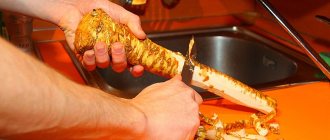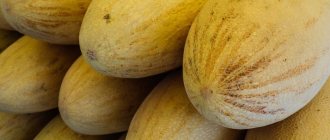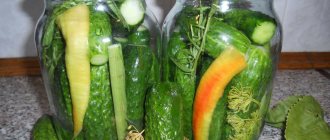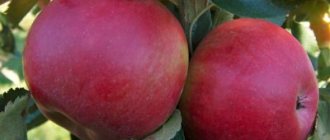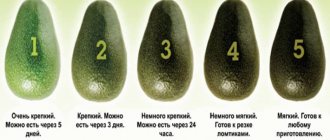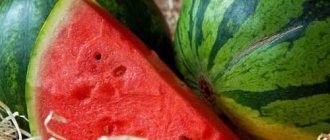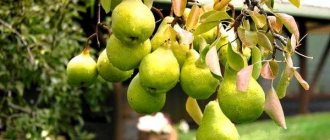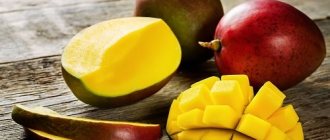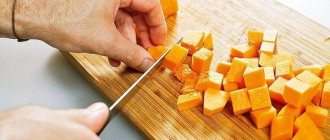Ripe sweet melon is not only tasty, but also healthy, but choosing just the right one is not so easy. Torpedoes, Kolkhoz Women, Gulyabi lie on the shelves in the markets and at first glance look appetizing. However, not all people know how to choose juicy fruits: even a beautiful melon may taste tasteless or too watery. Our advice will tell you what selection criteria exist and how to buy a good melon and enjoy it.
Best time to buy
Melon pulp is more than half water (about 90%). The composition also contains microelements: potassium, iron, zinc, sodium, magnesium, phosphorus, vitamins B, A, E, C. Due to its rich composition, the fruit has a number of useful qualities:
- increases immunity;
- improves digestion;
- relieves headaches;
- increases hemoglobin levels;
- lifts the mood.
Due to its low calorie content (only 35-40 kcal per 100 g), melon is loved by those losing weight; it is an excellent alternative to cakes and sweets, since it is not inferior to them in sweetness, but the number of calories consumed is reduced several times. Melons are sold already with the onset of summer, but buying them at the beginning of the season is very risky. Most often, such fruits are grown under artificial conditions: ripening is accelerated with chemicals, which, in addition to nutrients, causes harmful elements to appear in the pulp. If ingested, they can cause food poisoning, so you should not buy fruits in June or even early July, it is very risky.
The ripening period approaches the end of July or the beginning of August and lasts until mid-September. By this time, the harvest is ripe in Uzbekistan and other nearby countries: the fruits ripen completely in the sun naturally, which means they taste sweet. If you love melons and do not want to be poisoned by a low-quality product, go to the market no earlier than the beginning of August.
The most popular representatives of the melon crop are the varieties Torpeda, Kolkhoznitsa, Gulyabi, Rebristaya, Bukharka, Kassaba, Ananasnaya.
On a note!
Despite its beneficial qualities, not everyone can eat melon. Doctors exclude it from the diet of diabetics and those who have gastrointestinal problems.
One of the simplest ways to cut a melon: instructions
- One of the simplest ways to cut a melon: instructions
- How to decorate a pie: 7 easy ways
- Melon punch
- What dishes can be prepared from melon
- Melon;
- Cutting board;
- Slicing knife;
- A container or a beautiful dish that will decorate your table.
We recommend reading: When and How to Harvest Leaf Celery
We wash the melon well and, using a cutting board and knife, cut off the ends of the melon on both sides, as shown in the photo.
It is preferable that the knife be sharp. This way, there won't be as much juice on your cutting board, and it will remain in the cut pieces.
Then, cut off the melon rind from the edge. Make sure to cut as close to the edge as possible, as we want there to be more melon than waste.
This way we clean the entire surface of the melon and move on to the next step.
Now you need to turn the halves over on a cutting board and cut them into cubes, as if you were cutting, for example, a pumpkin.
Maybe along the way you will get the idea to cut additional slices of other fruits, making a fruit platter to serve. Melon has a good combination with peach, pear, strawberry, raspberry and other sweet berries.
Transfer the melon slices to the prepared bowl.
When serving, the dish can also be decorated with green mint or lemon balm leaves. And if there is any melon left after the feast, you can easily close it and put it in the refrigerator until your next snack.
Now you need to turn the halves over on a cutting board and cut them into cubes, as if you were cutting, for example, a pumpkin.
Criterias of choice
If you go to the store and want to buy a melon, under no circumstances take the first one you come across. You can’t rush, there’s a high chance of running into bad fruit. It’s better to take a closer look, hold it in your hands, twirl it, and only then go to the checkout. To make it easier for you to decide, remember several criteria for determining ripeness.
Appearance
Take a closer look at the size, it should not be large or small. Small fruits do not have time to ripen, and large ones are most likely overfed with nitrates. A good melon should be medium in size. Then evaluate the color of the skin. If it is light yellow, it means the fruit is ripe. A greenish tint indicates obvious immaturity, and bright yellow, on the contrary, indicates overripeness. A ripe melon will have orange veins appearing on its skin (usually this is clearly visible on Torpedo), but Kolkhoznitsa’s skin will have a mesh visible on its skin.
Sound
You can determine its ripeness by the sound the fruit makes. Pat the melon peel and listen: the sound that appears should not be loud. By the way, the sound of a watermelon will be the opposite - when it slams, a ringing sound is heard, but a melon will sound dull. If you hear a watery sound, then the pulp is not yet ripe, which means you should not buy the fruit.
Attention!
Take the melon in your hands and press the skin a little with your fingers. If your fingers fall through, then the fruit is too soft: perhaps it was kept warm for a long time, which means the pulp is probably overripe and will soon spoil, so you shouldn’t buy it.
Tail
Any melon should have a tail on one side; it will just help you with your choice. Twist the fruit in your hands and take a closer look. If the tail is plump, but has already dried down to the base, then the melon is fully ripe. But the presence of a green and not dry tail indicates immaturity or that the melon has been lying around for too long and has already deteriorated.
Smell
To be sure of the ripeness of the melon pulp, smell the skin. The smell should be pleasant, it resembles vanilla, pineapple, honey. If the aroma does not come from the skin or it is grassy, then this is a clear sign of immaturity. If a sharp unpleasant odor appears from the peel, definitely refuse to buy it - this melon has long since deteriorated and is not suitable for consumption.
Pests and diseases
Young Torpedo melon can be attacked by insect pests. The melon aphid sucks all the juices out of the plant, which eventually dies. The parasite can be detected by examining the underside of the leaves. To prevent the appearance of aphids, you need to regularly loosen the soil and clear the rows of weeds. Also dangerous is broomrape, which destroys melon flowers. It is necessary to detect the parasite in a timely manner and breed a phytomiza fly, which will destroy the pest.
Powdery mildew and fusarium wilt are common diseases. When a powdery coating appears, the Torpedo melon becomes fragile, the leaves become covered with brown spots. The disease is fought by spraying the bushes with phytoncides, chemicals, a solution of nettle and copper sulfate. Fusarium is characterized by spotting, after which the plant can survive for 7-10 days. The disease will be prevented by spraying the bushes with a solution of potassium chloride.
- https://vsepolezno.com/dynja/torpeda-polza-i-vred/
- https://ferma.expert/rasteniya/kustarniki/dynya/torpeda/
- https://www.syl.ru/article/206854/new_dyinya-torpeda-kaloriynost-polza-opisanie
- https://fructberry.ru/frukty/dynya-torpeda
- https://fruitree.ru/obrabotka-sadovyh-kultur/dynya-polza-i-vred-dlya-zdorovya.html
- https://fructify.ru/frukty/dynya-torpeda-opisanie-sorta
- https://glav-dacha.ru/o-polze-i-vrede-dyni-torpeda/
- https://fermilon.ru/sad-i-ogorod/ovoshhi/dynya-torpeda-kak-vybrat-i-kak-vyraschivat.html
- https://vsedlypolsy.ru/dynya-torpeda-polza-i-vred-dlya-zdorovya.html
- https://agrognom.ru/berries/melon/dynya-torpeda-kak-vybrat-sladkuyu-speluyu-kak-vyrashhivat.html
How to determine nitrates
The main danger when choosing melons is the possible presence of nitrates in the pulp. It is impossible to determine their content by eye, so measurements are carried out with special devices. Nitratomers are sold in gardening products and cost about 5-7 thousand rubles. Using them, you can find out the amount of nitrates not only in melon, but also in fresh meat, water and other vegetables and fruits.
If you don’t want to buy a device, then simple tips will help:
- buy melon no earlier than the beginning of August, and even better in the middle of the last month of summer;
- before purchasing, ask the seller to show a certificate for the crop being sold;
- choose a medium-sized fruit that is not overgrown.
If, when cut, you saw empty gray seeds and gray fibrous “threads,” then the melon was clearly fed with nitrates. Another sign of chemical exposure is the presence of a distinct yellow stripe between the peel and the pulp. If you suspect something is wrong, then do not eat suspicious fruits, because you can get poisoned.
How to choose a Torpedo
Most often in the markets you come across an oblong-shaped melon with a light yellow skin - this is the Torpedo variety. When purchasing it, evaluate the fruit for compliance with the above parameters: look at the tail, knock, smell. A good Torpedo will weigh about 2-4 kg; if the weight is greater than these values, then choose another fruit. Pay attention to the color of the skin: the color should be uniform, and longitudinal yellow stripes appear over the entire area.
There should be no damage or cracks on the skin. If they occur, even in small quantities, they can easily become infected with infections - botulism, salmonellosis and other dangerous pathogens. When buying a Torpedo at the market, never ask the seller to cut a piece for testing. The knife may turn out to be unclean, and bacteria from the skin, when cut, enter the pulp, where they rapidly multiply.
Attention!
Choose those melons that are on the trays on top. If the fruits are on the ground, it is dangerous to buy them.
Characteristics of the variety
We love the Torpedo melon variety for its exceptional sweetness, unique aroma and juiciness. This Uzbek melon has a characteristic elongated shape and yellow skin, which is completely covered with a mesh-like rough pattern.
The variety is considered heat-loving, and the fruits in their homeland can reach a weight of 15 kg! In our latitudes, due to lack of heat, you should not count on such sizes; the maximum possible fruit can be about 5 kg. The variety is late, the fruits ripen by the end of August. This is precisely the most common reason for purchasing low-quality berries: everything that was previously sold was collected unripe and reached the desired state solely through the use of specific substances that are dangerous to human health.
How to choose a collective farmer
The Kolkhoz Woman differs from the Torpedo by its small size and rounded shape. In terms of weight, it extends by 1-2 kg. The color is bright, yellow-orange, uniform. There should be no greenish or brown spots on the skin; if there are any, then the fruits are either not fully ripe or overripe. If the Kolkhoznitsa has dents or damage, it is no longer safe to eat it. Most likely, the fruits were damaged during transportation, which means rotting has begun in the pulp. To choose a sweet Kolkhoz Woman, evaluate the aroma of her skin - it will be pleasant and distinct. The smell from the peel is delicate, reminiscent of vanilla and honey. If the melon smells cloying and unpleasant, it is likely that it has gone bad.
Melon is too soft - reasons
When you press on the nose of the melon, opposite the stalk, you feel a slight bend under your finger. If excessive softness of the fruit is felt in this place, this means that the melon is either overripe or has been stored for a long time in not the best conditions. There is a practice of scratching the skin of the melon, but this destroys its integrity.
To buy a melon that is not only tasty, but also healthy, you need to make sure of its quality. Externally, the fruit should not be damaged. It should have a pleasant, tasty aroma. If you press on the melon in the place opposite the stalk, it should bend slightly. If the melon is too soft, it means it is overripe or has been stored for too long. Some people advise scratching the skin, but it is better not to do this, as the integrity of the surface is compromised.
Choosing Gulyabi
Gulyabi is found on shelves less often than Torpedoes and Kolkhoznits, but in taste it is in no way inferior to these melon varieties. Ripe Gulyabi should have the following signs:
- the color of the skin is rich yellow or orange;
- the ripened peel has a continuous mesh;
- a pleasant honey aroma emanates from the skin;
- elongated shape, weight should not exceed 6-7 kg.
Gulyabi ripens much longer than other varieties: it will take more than 100 days to ripen, so it only appears on sale in the fall.
On a note!
Do not buy melons near roads. Over time, heavy metals released from car exhaust accumulate on the fruit skin and in the pulp.
Storage rules
When purchasing melon, place it in a cool place. In its entirety, it can be stored for up to 2 weeks, and if you cut it into pieces, you need to eat it within a day, maximum two. In the pulp, large amounts of sugar rapidly cause the proliferation of microorganisms, which can cause poisoning. When storing, follow the rules:
- Only unripe and ripe melons are suitable for long-term storage. Late-ripening varieties will last longer than early-ripening crops;
- do not keep melons near heating or heating devices;
- remove the fruits away from potatoes and apples, this will extend the period;
- You can put the melons in wooden, ventilated boxes and take them out to the balcony or put them in the basement. The option of hanging from the ceiling is also acceptable;
- periodically turn the melon on different sides so that the sides do not “sag”;
- If you bought several fruits, then when storing them, place cardboard or paper between adjacent fruits; there should be no contact.
If you have a few pieces of sweet pulp left, wrap them in film or place them in a container and place them in the refrigerator, but away from foods that emit odors. Melon pulp perfectly absorbs aromas. Another option is to freeze the pieces, which will keep them for up to one year. However, after defrosting, the slices will lose their shape, so they can be used in crushed form, for example, added when preparing smoothies, fresh juices, and sweet fillings. But the most interesting recipes are salads with melon; they turn out very tasty.
A ripe sweet melon will not only bring pleasure, but will also improve the health of the body, because it is very healthy. Don’t be lazy and take a few minutes to choose a fruit, this is the only way to protect yourself from buying a low-quality product.
What to do with melon at home?
Store it in a cool, dry place, away from direct sunlight. Place on a wooden cutting board or linen towel. Under no circumstances should you place it on linoleum, polyethylene or tiles. If possible, hang it in a string bag. The point is that it doesn't come into contact with anything.
Depending on the degree of maturity, the Torpedo will last from 2-3 days to two to three weeks. The main thing is the presence of the stalk and intact peel. If the melon has been dropped or hit too hard, it will begin to spoil from the inside. By the time you notice, it will be too late. Handle it carefully.
I advise you to eat the fully ripened fruit as quickly as possible. Before use, wash it thoroughly with soap and wipe dry. To be sure, I additionally pour boiling water over it.
After cutting, inspect the “insides” and evaluate the smell. This is the last stage of quality control.
Use a clean, dry knife. I cut it lengthwise into 2 pieces and scoop out the seeds with a spoon. I put one half on the table, and wrap the other half in plastic and hide it in the refrigerator. There it will calmly retain its properties for a day or two. I don't recommend leaving it in a warm place. At room temperature, melon will quickly spoil.
If you want to serve it beautifully, cut it crosswise, place it vertically and divide it into wedges, removing the top. Or cut off the edible part, divide into matchbox-sized pieces and place on a plate, pierced with toothpicks. This option is suitable for treating guests. The downside is that the juice leaks out quickly.
Melon is good on its own. In addition, it is an excellent raw material for candied fruits, jams or fruit salads. The fruits are also dried, dried, and frozen.
Do not combine the product with milk, alcohol or cold carbonated drinks. It is better if 2-2.5 hours pass after the main meal.
Melon jam
If you don’t have time to eat your “Torpedo”, it turned out to be not too sweet, make jam:
- Remove peel and seeds.
- Divide into 2cm cubes.
- Add sugar at the rate of 1:1 or 1:0.8.
- Leave for several hours or overnight to release the juice.
- Bring to a boil.
- Wait another 6-8 hours.
- Boil for 5-7 minutes, place in jars and seal tightly.
You will get an excellent preparation for the winter, which itself “begs” for toast or as a layer for a cake.


